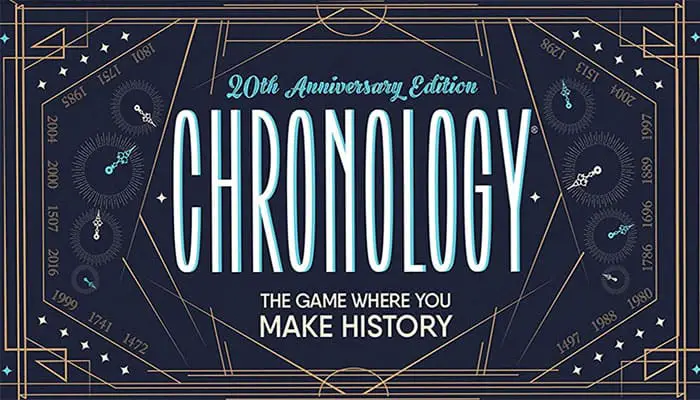

Components
- 200 event cards
- 6 game trays
- Instructions
Object of the Game
To collect a total of five event cards by correctly guessing where each card should be placed in chronological order in each player's timeline. Choose to play with all categories or one category only.

Game Play
Shuffle the cards and place them year side down in the middle of the
table. Each player draws a card, reads it out loud and then places it in any slot in their card tray. This card represents the first card in the player's timeline.
One player begins by drawing a card from the stack and reading the information out loud to all the players without revealing the date. The player to the left then starts by deciding whether the event occurred before or after the card in their card tray.
If the player guesses correctly, then the player wins the card and places it in the card tray in the proper order in their timeline. Each card in the player's timeline breaks up that timeline into segments.
On the next turn, the player will have to determine whether the card should be placed before, after or in between the cards in their timeline. Each player works only with their own timeline, but each player may look at the timeline of the other players and learn from the information contained in their cards.
Example: There are four cards in a player's timeline: 1492, 1787,1903, and 1984. The choices the player has are: before 1492, between 1492 and 1787, between 1787 and 1903, between 1903 and 1984, or after 1984.
The player must announce the dates out loud as they guess because, if they miss, the other players have an opportunity to win the card after listening to the mistake of their opponent.
If the year on the card is in the position guessed by the player, (example: The card is 1984 and the player guesses between 1903 to 1985), then the player wins the card. Note: In case of a player holding more than one card for a given year, the card in play can correctly be placed before or after the duplicate year card.

If the player guesses incorrectly, the next player to the left may win the card by correctly guessing where it fits in their own timeline. If that player misses, then the play proceeds around the table to the left, allowing the next player to guess.
If no one guesses correctly, then the player reading the card will announce the date on the card, then put it back in the box.
The next player to the left then reads the next card to the player to their left. That person will now guess first where the card should be placed in their timeline.
The game continues in this manner until one person accumulates five cards in their timeline. That player is the winner and the game is over. The cards may be reshuffled and play may begin again. Although the same cards may come up in play in other games to follow, each game will create a different timeline for the players.
The "c". Symbol
The "c". appearing before some of the dates means "around" or "about". Some dates are very difficult to pinpoint. Or perhaps historians disagree as to exactly when the event occurred.
Please be aware that as our ability to understand and evaluate history improves, the dates of certain important events may change. We have used the most accurate and current information available to us as of the date of publication.
Continue Reading


